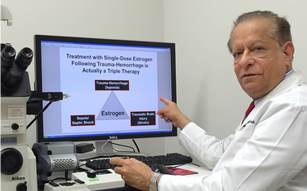Psychological Health/Traumatic Brain Injury
Treatment of TBI with Hormonal and Pharmacological Support, Preclinical Validation Using Diffuse and Mechanical TBI Animal Models
Posted May 11, 2016
Irshad H. Chaudry, Ph.D., University of Alabama at Birmingham
 Blast injuries from unconventional urban warfare, most notably through improvised explosive devices, have increased the frequency and severity of blast-induced trauma; specifically, traumatic brain injury (TBI). While lifesaving advances in military medicine have tremendous success rates for blast-induced trauma, the surviving Soldiers are returning with serious long-term injuries that significantly affect their quality of life and challenge the military medical system. Dr. Irshad Chaudry was awarded the TBI Advanced Technology-Therapeutic Development Award through the Physiological Health and Traumatic Brain Injury Research Program with the proposed treatment of estrogen to ameliorate the consequences of TBI, to alleviate symptoms and care for the patient, his or her family, and medical providers.
Blast injuries from unconventional urban warfare, most notably through improvised explosive devices, have increased the frequency and severity of blast-induced trauma; specifically, traumatic brain injury (TBI). While lifesaving advances in military medicine have tremendous success rates for blast-induced trauma, the surviving Soldiers are returning with serious long-term injuries that significantly affect their quality of life and challenge the military medical system. Dr. Irshad Chaudry was awarded the TBI Advanced Technology-Therapeutic Development Award through the Physiological Health and Traumatic Brain Injury Research Program with the proposed treatment of estrogen to ameliorate the consequences of TBI, to alleviate symptoms and care for the patient, his or her family, and medical providers.
Dr. Chaudry's lab has spent the past several years studying the ability of ethinyl estradiol-3-sulfate (EE-3-SO4) to ameliorate TBI damage (i.e., to reduce intracranial pressure immediately or cerebral edema) after a TBI injury in a rat model. He envisions a stable and readily transportable drug that can be delivered by medics (or buddies with an autoinjector) to wounded Warriors in the field to stabilize and protect them during transport to an in-theatre medical facility for definitive treatment. Dr. Chaudry and his research team studied administration of EE-3-SO4 both during the "golden hour", defined as the first 60 minutes post-injury in which early intervention can have the greatest impact on outcomes, as well as several hours after injury. Treatment with the compound reduced intracranial pressure and blood loss in both time frames. Using specialized magnetic resonance imaging (MRI), Dr. Chaudry was able to show that rapid delivery of the compound reduced the volume of edema built up in rodent brains after injury by 50 percent within 24 hours of injury. Subsequent experiments also have explored memory, physical activity, limb control, and anxiety responses in rodents after TBI with or without administration of this novel drug. Animals that received the drug recovered with normal anxiety responses and improved limb control to near baseline levels. This progressive work was recently submitted to the Journal of Neurotrauma and Drs. William Hubbard and Chaudry have authored a chapter that discusses the project in the forthcoming book "New Therapeutics for Traumatic Brain Injury: Prevention of Secondary Brain Damage and Enhancement of Repair and Regeneration," to be released in 2016.
Furthermore, Dr. Chaudry's group demonstrated during the Defense Advanced Research Projects Agency's Surviving Blood Loss Initiative that EE-3-SO4 could treat severe blood loss in animals, promoting up to 6 hours survival after a traumatic event. This finding is likely to have a major impact on Warfighters who cannot be evacuated promptly, as well as civilians in traumatic injury settings, where the first responders can deliver the drug immediately, at the point of injury, to minimize long-lasting symptoms and medical care. In the future, Dr. Chaudry and his research team will assess the compound's efficacy as a preventative agent against cognitive and memory deficits. This new initiative has been recently supported by a Department of Defense award intended to conduct a Phase I clinical trial.
Links:
Last updated Monday, March 10, 2025














